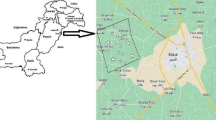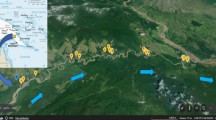Abstract
Photon activation analysis (PAA) is a multi-elemental radioanalytical technique in trace elements analysis with high accuracy and precision. Researchers at the Idaho accelerator center performed PAA analysis on coffee samples from several locations around the world as an initial step in assessing the relationship between trace elements in illicit drugs and the soils in which they were grown. The preliminary results show coffees from different locations have different concentrations of trace elements. In the three cases where we have soil samples, the matrices of elements in the coffee samples are closely related to the matrices of the elements of the local soil samples. The majority of trace elemental content is similar to that of the local soil sample in which the coffee is planted. It may be that coffee assimilates numerous elements from the soil where it is grown in similar ratios as is found in the soil. Thus, it is conceivable that the elemental content could serve as “fingerprint” to trace the origins of the coffee. To verify our analytical results we applied X-ray fluorescence (XRF) methods as well. Our PAA results are consistent with XRF experimental data. The future of tracing the origin of illicit drugs with the PAA technique is promising.








Similar content being viewed by others
References
Mezhiborskaya KB (1961) Photoneutron method for determining beryllium. Gosatomizdat, State Press for Literature of Atomic Science and Technology, Moscow
Gv Hevesy, Levy H (1936) The action of neutrons upon the rare earth elements. Mat-Fys Medd 14:3–34
Seaborg GT, Livingood JJ (1938) Artificial radioactivity as a test for minute traces of element. J Am Chem Soc 60:1784–1786
Segebade C, Berger A (2006) Photon activation analysis in encyclopedia of analytical chemistry. Wiley, New York
United Nations Office on Drugs and Crime. World Drug Report 2010. Retrieved Jan 21, 2011
World failing to dent heroin trade, U.N. warns, CNN.com. October 21, 2009
UN report puts world’s illicit drug trade at estimated $321B. Boston.com. June 30, 2005
Segebade C, Weise HP, Lutz GJ (1987) Photon activation analysis. W. de Gruyter, Berlin
Sun ZJ, Segebade C, Wells, Maschner H, Benson B (2011) Determination of trace elements in coffee by photon activation analysis. AccApp ‘11—tenth international topical meeting on nuclear applications of accelerators, Knoxville, TN
Sun ZJ, Wells D, Segebade C, Green J (2011) Standardizing activation analysis: new software for photon activation analysis. AIP Conf Proc 1336(1):473–478
Mamtimin M, Cole P, Segebade C (2011) Photon activation analysis of dust particles for environmental research and applications using the 44 MeV electron LINAC at the Idaho accelerator center. AccApp ‘11—tenth international topical meeting on nuclear applications of accelerators, Knoxville, TN
Sun ZJ, Wells D, Segebade C, Green J (2011) Web-based spectrum analysis software for photon activation analysi. J Radioanal Nucl Chem. doi:10.1007/s10967-011-1209-5
Cranes software (1997) Systat for Windows. Prentice-Hall, SpSS, Upper Sandel River, New Jersey
De Nadai Fernandes EA, Tagliaferro FS, Adriano A-F, Bode P (2002) Organic coffee discrimination with INAA and data mining/KDD techniques: new perspectives for coffee trade. Accredit Qual Assur 7(10):378–387. doi:10.1007/s00769-002-0531-6
Acknowledgments
This work was funded by the U.S. Department of Energy under Grant No. DE-FC07-06 ID14780. The authors also thank Josie Thompson of the Foundation for Anthropological Research and Environmental Studies in Guatemala and some other colleagues in Republic of Colombia, who provided enormous assistance in collecting coffee beans and soil samples.
Author information
Authors and Affiliations
Corresponding author
Rights and permissions
About this article
Cite this article
Sun, Z.J., Wells, D.P., Segebade, C. et al. A provenance study of coffee by photon activation analysis. J Radioanal Nucl Chem 296, 293–299 (2013). https://doi.org/10.1007/s10967-012-2021-6
Received:
Published:
Issue Date:
DOI: https://doi.org/10.1007/s10967-012-2021-6




